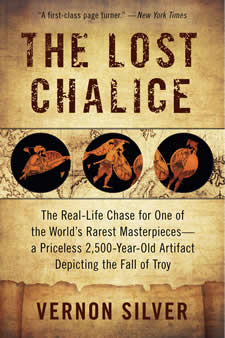The Real-Life Chase for One of the World’s Rarest Masterpieces - a Priceless 2,500-Year-Old Artifact Depicting the Fall of Troy
“A riveting story of tomb robbers and antiquities smugglers, high-stakes auctioneers and the princely chiefs of the world’s most prestigious museums….A terrific read, from start to finish.”
—James L. Swanson, New York Times bestselling author of Manhunt
 Sotheby’s. New York City. June 19, 1990
Sotheby’s. New York City. June 19, 1990
Nothing of its kind had been sold to the public in more than a century. On this rainy June evening on Manhattan’s Upper East Side, with the auction-house showroom crammed with the wealthy, the curious, and the press, history was made when an anonymous man in a green golf sweater won the 2,500-year-old chalice. After that night, this historical artifact disappeared, its whereabouts a mystery. Until now.
It is among the most prized of antiquities—the Greek artist Euphronios’s wine cup depicting the death of Zeus’s son Sarpedon at Troy. Its bigger twin, the legendary Euphronios Krater, was already famous as the centerpiece of the Metropolitan Museum of Art’s ancient collection. Lost for more than two millennia, the chalice—one of only six of its kind found intact—mysteriously surfaced in the collection of a Hollywood producer who sold it to a Texas billionaire. Coveted by obsessed private collectors, dealers, and museum curators, it was also of intense interest to the Italian police, who believed it belonged to the country where it had been dug up earlier in the 20th century.
In this tale of history, adventure, and intrigue, archaeologist and journalist Vernon Silver pieces together the extraordinary tale of this lost cup and offers a portrait of the modern antiquities trade: a world of tomb raiders, smugglers, wealthy collectors, ambitious archaeologists, rapacious dealers, compromised curators, and international law enforcement. Spanning 2,500 years, The Lost Chalice moves from the mythic battlefield of the Trojan War to the countryside of twentieth-century Rome, the dusty libraries of Oxford University to the exhibition halls of New York’s Metropolitan Museum of Art, the cramped law enforcement offices of the Carabinieri to the tony auction rooms of New York’s auction houses to solve the mystery of the world’s rarest masterpiece.
As Silver learns, the discovery of the chalice exposes another riddle—and even greater missing treasure. The Lost Chalice is a true-life detective story that illuminates an illicit, global trade second only to the traffic in weapons and drugs. Using a high-profile crime, Silver’s tale opens a window onto Italian history, culture, and life rarely seen, while exposing a worldwide network shrouded in mystery.
Read an excerpt (“at HarperCollins.com”)
Reviews
“The Lost Chalice describes the seedy underworld of the antiquities trade in such vivid detail that one can almost smell the fresh earth of a pillaged archeological site.”
— Barbie Latza Nadeau, “The Daily Beast”
“In his brilliant The Lost Chalice Vernon Silver has gone far beyond merely slicing open the Gordion knot obscuring the world-famous ancient Greek chalices made by Euphronios, the Leonardo of the 6th century BC, he has patiently untied that knot in a spine-tingling read.”
— Thomas Hoving, former director of the Metropolitan Museum of Art
“A captivating tale of ancient art as a modern hot commodity… Silver’s telling is infused with an infectious curiosity about the illicit art trade and an equally infectious appreciation of the art itself.”
— Publishers Weekly
“Vernon Silver has written an utterly compelling, page-turner of a book.”
— James L. Swanson, author of Manhunt
“Vernon’s sharply rendered account is engrossing. A densely packed, dizzyingly detailed tale of art and espionage.”
— Kirkus Reviews
“The Lost Chalice: The Epic Hunt for a Priceless Masterpiece, just published by William Morrow, makes a first-class page turner out of the stolen krater’s travels from ancient Greece to Etruscan Italy to New York and then back here — and of the travails of another work also by the sublime Euphronios, a kylix, or chalice, which was looted from the same spot here in Cerveteri, a town northwest of Rome.”
— Michael Kimmelman, The New York Times
“The Lost Chalice shines a light on the dark world of stolen antiquities.”
— Tony Lewis, The Providence Journal
“Setting up his tale as a mystery to be solved Silver takes a micro approach to a great big problem, that of looted antiquities in modern times… a welcome glimpse into the modern, secret journey of such ancient objects.”
— Sharon Waxman, author of *Loot*